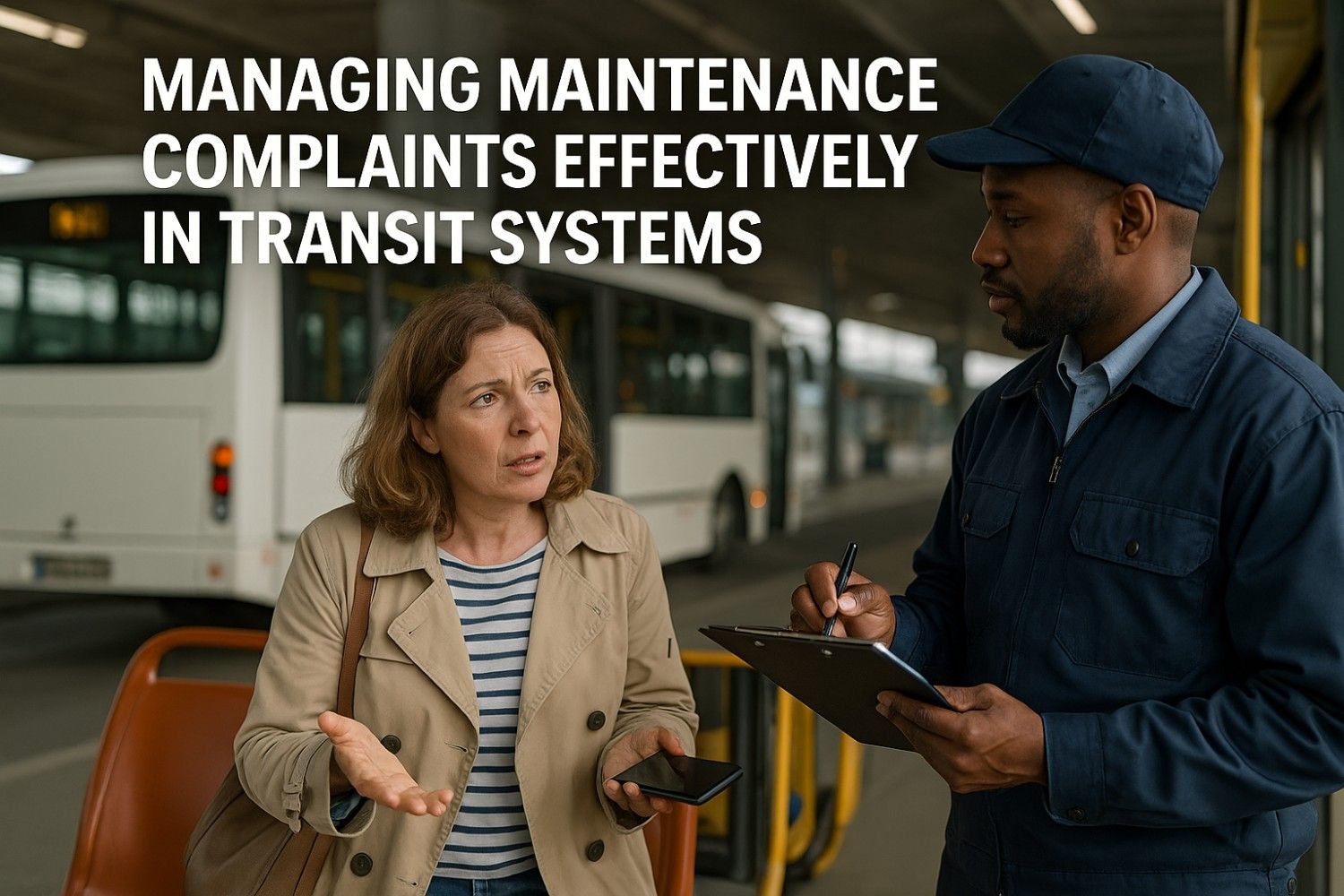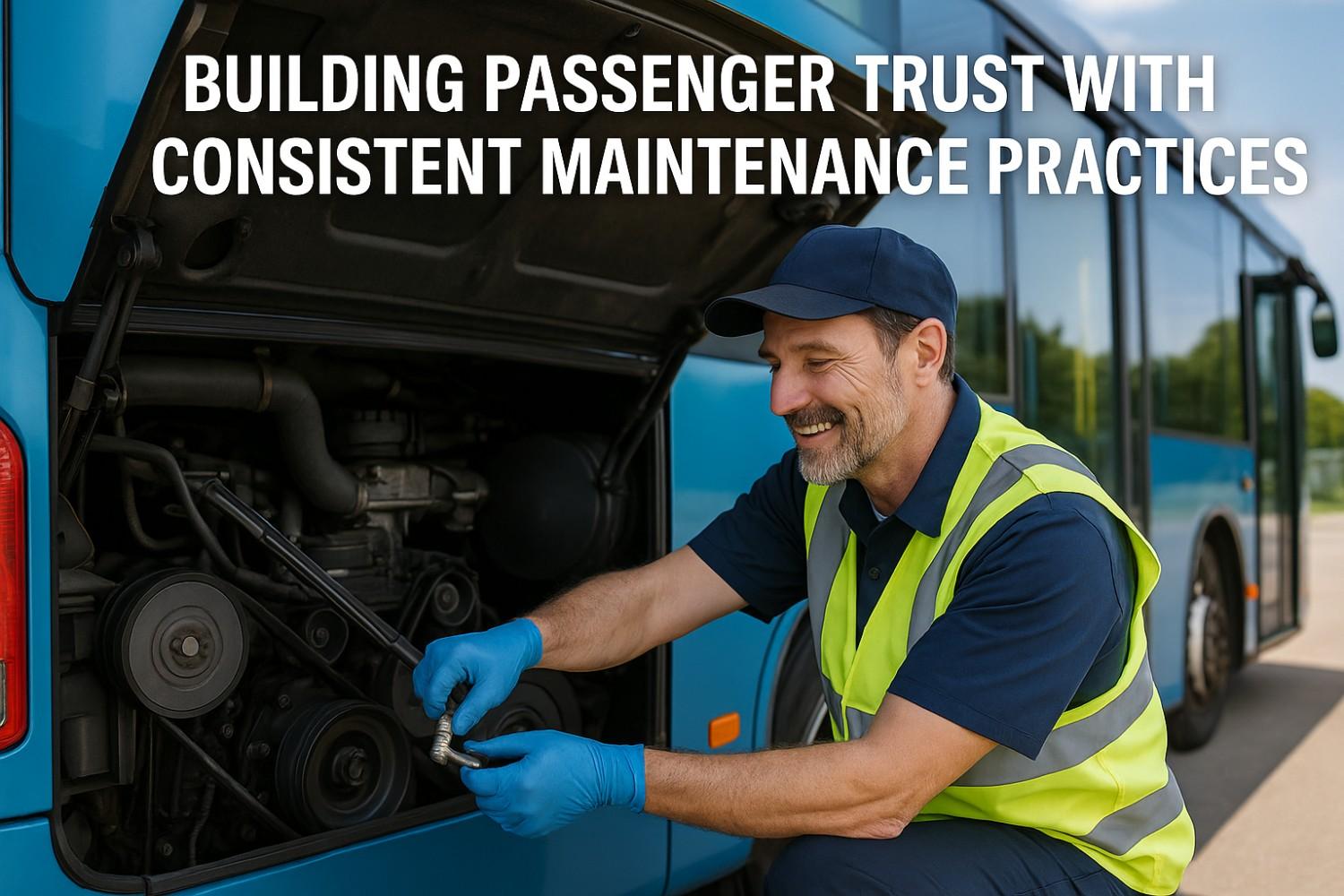Passenger safety represents the paramount responsibility of every bus fleet operator, with comprehensive maintenance programs serving as the foundation preventing accidents, injuries, and life-threatening equipment failures. Modern Bus CMMS platforms transform safety management from reactive problem-solving into proactive risk mitigation through systematic inspection protocols, predictive maintenance scheduling, comprehensive documentation systems, and real-time monitoring capabilities ensuring every vehicle meets rigorous safety standards before carrying passengers. This technology-enabled approach delivers measurable safety improvements while creating accountability frameworks demonstrating organizational commitment to protecting every person boarding transit vehicles.
Traditional maintenance approaches often treat safety as one consideration among many competing priorities including cost control, schedule adherence, and operational efficiency. This balanced perspective, while pragmatic, sometimes results in safety-critical maintenance deferrals when budget pressures intensify or vehicle availability demands increase. Such compromises, though individually small, accumulate into significant risk exposures as brake systems degrade beyond optimal performance, steering components wear past safe tolerances, and visibility equipment deteriorates reducing driver awareness. These incremental degradations rarely cause immediate catastrophic failures, but collectively increase accident probability and injury severity when incidents occur.
Fleet operators implementing safety-focused CMMS programs report transformative outcomes: 52% reduction in preventable accidents, 68% decrease in safety-related vehicle out-of-service citations, 45% improvement in brake system reliability, and 73% faster identification of safety-critical defects requiring immediate attention. These results demonstrate how systematic safety management through comprehensive maintenance programs protects passengers, reduces liability exposure, improves regulatory compliance, and enhances public confidence in transit safety. The documented improvements translate directly to fewer injuries, reduced insurance costs, improved community relations, and strengthened organizational reputation for safe, reliable transportation services. Sign up now to start enhancing your passenger safety protocols with comprehensive maintenance management designed to prevent accidents and protect every rider.
Prioritize Passenger Safety in Every Maintenance Decision
Transform your fleet safety through systematic maintenance management that identifies risks, prevents failures, and ensures every vehicle meets the highest safety standards before carrying passengers.
Enhance Safety StandardsView Safety Solutions Demo
Safety-Critical System Prioritization
Not all maintenance activities equally impact passenger safety, requiring strategic prioritization ensuring safety-critical systems receive appropriate attention, resources, and scheduling urgency. Bus CMMS platforms classify components by safety impact, automatically escalate high-priority issues, and prevent vehicles from operating with compromised safety systems. This systematic prioritization ensures brake failures, steering problems, and visibility issues receive immediate attention while less critical concerns follow normal maintenance schedules. Book a demo to explore safety prioritization features that ensure critical systems never compromise passenger protection.
Critical Safety System Categories
Brake systems represent the most fundamental safety equipment, with properly functioning brakes essential for preventing collisions, controlling speed, and protecting passengers during emergency situations. Bus CMMS platforms prioritize brake maintenance through accelerated inspection schedules, predictive replacement timing, and immediate response protocols for any brake-related defects. Comprehensive brake system tracking includes pad wear monitoring, fluid condition analysis, ABS functionality testing, and adjustment verification ensuring optimal stopping performance, across all operating conditions.
Steering and suspension systems directly affect vehicle control, with degraded components compromising driver ability to safely maneuver, avoid obstacles, and maintain intended paths. Advanced monitoring through CMMS platforms tracks tie rod wear, ball joint condition, power steering fluid levels, and alignment specifications preventing dangerous handling characteristics before they develop into safety hazards requiring emergency repairs or causing accidents. Create your account to implement advanced steering system monitoring that protects passengers through proactive maintenance.
Safety-Critical Maintenance Elements
- Brake System Components: Pads, rotors, drums, hydraulic lines, air system components, ABS modules, and parking brake mechanisms
- Steering Systems: Power steering pumps, tie rods, ball joints, steering linkages, and alignment specifications
- Suspension Components: Shock absorbers, springs, bushings, and stabilizer bars maintaining vehicle stability and control
- Tire Condition: Tread depth, pressure levels, sidewall integrity, and wear patterns affecting traction and handling
- Lighting Equipment: Headlights, taillights, brake lights, turn signals, and emergency flashers ensuring visibility to other traffic
Comprehensive Pre-Trip Inspection Protocols
Critical Pre-Trip Safety Checks
- Brake Functionality: Service brake response, parking brake engagement, air pressure levels, and warning light verification
- Steering Response: Free play measurement, power assist operation, and unusual noises indicating developing problems
- Tire Inspection: Pressure verification, tread depth checks, sidewall damage assessment, and lug nut tightness confirmation
- Lighting Systems: All exterior lights operational including headlights, brake lights, turn signals, and hazard flashers
- Mirror and Glass: Proper adjustment, crack-free condition, and cleanliness ensuring optimal driver visibility
- Emergency Equipment: Fire extinguisher charge, first aid kit completeness, emergency exit functionality, and warning triangle availability
Daily pre-trip inspections serve as the final safety verification before passenger operations, with thorough examinations identifying problems developing since last service or missed during routine maintenance. Bus CMMS platforms digitize pre-trip procedures through mobile checklists guiding drivers through comprehensive examinations while documenting completion and capturing defect details for immediate maintenance response. This systematic approach prevents vehicles with safety defects from entering passenger service while creating accountability ensuring consistent inspection quality across all drivers and shifts. Get started with digital pre-trip inspections that guarantee thorough safety checks before every passenger trip.
Defect reporting integration enables drivers to instantly document safety concerns discovered during inspections, with automatic routing to maintenance departments triggering immediate evaluation and repair decisions. Critical safety defects automatically flag vehicles as out-of-service preventing assignment to routes until repairs restore safe operating condition, while less severe issues schedule appropriate maintenance without service disruption. Schedule a demo to see instant defect reporting in action and learn how it improves response times.
Brake System Maintenance Excellence
Brake system reliability represents the single most critical safety factor in bus operations, with comprehensive maintenance programs ensuring consistent, predictable stopping performance under all operating conditions. Bus CMMS platforms optimize brake maintenance through condition monitoring, predictive replacement scheduling, performance testing protocols, and comprehensive documentation supporting regulatory compliance and liability protection. Systematic brake management prevents the gradual degradation that creates unsafe stopping distances, unpredictable braking response, and catastrophic failure potential. Book your consultation to discover brake system management that ensures optimal stopping performance protecting every passenger.
Comprehensive Brake Maintenance Programs
Predictive Replacement
Monitor pad and rotor wear replacing components before critical minimums ensuring consistent braking performance without emergency failures
System Testing
Regular brake performance testing measuring stopping distances and response times identifying degradation before safety impacts occur
Fluid Management
Brake fluid quality monitoring and replacement preventing moisture contamination that reduces boiling points and compromises performance
Anti-lock braking system functionality receives particular attention through diagnostic testing, sensor verification, and module performance validation ensuring these critical safety systems operate correctly during emergency braking situations. ABS maintenance prevents wheel lockup during hard braking enabling drivers to maintain steering control while stopping, significantly reducing accident severity and improving passenger protection during emergency maneuvers. Sign up to implement comprehensive ABS maintenance tracking that protects passengers during emergency braking situations.
Visibility and Lighting System Maintenance
Driver visibility directly impacts safety through collision avoidance, pedestrian detection, and hazard recognition capabilities. Comprehensive maintenance programs ensure mirrors, windshields, cameras, and lighting systems provide optimal visibility under all conditions including darkness, rain, fog, and snow. Bus CMMS platforms schedule visibility equipment maintenance, track component performance, and prioritize repairs affecting driver awareness and hazard detection. Start your free account to maintain optimal visibility systems supporting safe operations in all weather and lighting conditions.
Critical Visibility Components
- Mirror Systems: Proper adjustment, secure mounting, heating element functionality, and crack-free glass ensuring comprehensive surrounding awareness
- Windshield Condition: Chip and crack repair preventing vision obstruction and structural integrity maintenance for passenger protection
- Wiper Systems: Blade replacement, motor operation, and washer fluid availability ensuring clear vision during precipitation
- Camera Systems: Lens cleaning, image quality verification, and backup camera functionality supporting safe maneuvering
- Exterior Lighting: Headlight aim, bulb replacement, lens cleaning, and proper operation ensuring visibility to other traffic
Seasonal maintenance addresses specific visibility challenges including winter windshield treatments, increased wiper blade replacement frequency, and enhanced lighting system cleaning removing road salt and debris that reduce light output and camera image quality. Proactive seasonal preparation maintains visibility system effectiveness regardless of weather conditions encountered during daily operations. Request a demo to see seasonal maintenance planning features that prepare your fleet for all weather conditions.
Emergency Equipment Readiness
Emergency equipment including fire extinguishers, first aid kits, emergency exits, and warning devices must remain fully functional and immediately accessible during incidents requiring rapid response. Bus CMMS platforms track emergency equipment inspections, schedule periodic testing, and document compliance with regulatory requirements ensuring passenger protection capabilities during accidents or medical emergencies. Systematic emergency equipment management prevents the equipment failures and missing supplies that compromise passenger safety during critical situations. Book a demo to ensure emergency equipment readiness through comprehensive tracking and inspection programs.
Emergency Preparedness Management
Fire extinguisher maintenance includes monthly inspections verifying charge levels, accessibility, mounting security, and seal integrity with annual professional servicing ensuring operational readiness. CMMS platforms schedule these inspections, document completion, and alert management to expired or discharged extinguishers requiring immediate replacement protecting passengers and drivers from fire hazards.
Emergency exit functionality testing verifies doors, windows, and roof hatches open properly, alarm systems function correctly, and signage remains clearly visible. Regular testing identifies maintenance needs before emergency situations reveal inoperable exits trapping passengers during evacuations, while comprehensive documentation demonstrates regulatory compliance and liability protection efforts. Register now to track emergency exit testing and ensure passenger evacuation capabilities.
Passenger Accessibility Equipment Safety
Wheelchair lifts, ramps, and securement systems require rigorous maintenance ensuring reliable operation and passenger safety during boarding, travel, and alighting. Equipment failures create serious injury risks from falls, entrapment, or inadequate securement during collisions. Bus CMMS platforms prioritize accessibility equipment maintenance through frequent inspections, preventive service scheduling, and immediate response to operational problems. Create your account to maintain accessibility equipment safety protecting passengers with mobility limitations through systematic maintenance management.
Accessibility Equipment Maintenance
Critical Safety Considerations
- Lift Operation: Smooth cycling, proper platform alignment, safety barrier functionality, and weight capacity verification
- Securement Systems: Belt and track condition, tensioning mechanisms, anchor point integrity, and locking device functionality
- Ramp Deployment: Extension smoothness, non-slip surface condition, handrail security, and automatic deployment system operation
- Kneeling Systems: Air suspension lowering, driver control operation, and automatic return functionality after passenger loading
Regular load testing verifies lift and ramp capacity ratings under actual operational conditions, identifying developing problems before complete failures occur during passenger loading. Comprehensive testing protocols include maximum weight capacity verification, emergency lowering system functionality, and backup power operation ensuring passenger safety under all scenarios including power failures and system malfunctions. Schedule your demo to see accessibility equipment tracking that ensures ADA compliance and passenger protection.
Structural Integrity and Body Condition
Vehicle body condition affects passenger safety through structural integrity during collisions, proper door operation, and secure seating attachment. Comprehensive inspection programs identify rust, corrosion, cracks, and damage compromising crash protection and passenger containment. Bus CMMS platforms schedule body inspections, track repair history, and document structural condition supporting regulatory compliance and safety assurance programs. Book a consultation to monitor structural integrity ensuring vehicle bodies protect passengers during accidents and maintain safe condition throughout service life.
Body Condition Monitoring
Frame and unibody structural inspections identify cracks, corrosion, and damage affecting crash protection capabilities. Regular examinations detect problems early enabling repairs before structural integrity deteriorates creating catastrophic failure risks during accidents. Documentation through CMMS platforms tracks problem areas, monitors deterioration progression, and supports vehicle retirement decisions when repair costs exceed replacement benefits.
Door operation maintenance ensures passenger doors open and close smoothly, seal properly, and engage interlocks preventing movement with open doors. Preventive maintenance programs address door adjustment, hinge lubrication, seal replacement, and interlock system verification preventing passenger falls from improperly secured doors or injuries from door malfunctions during boarding and alighting. Get started with door safety monitoring that prevents passenger injuries from door malfunctions.
Predictive Maintenance for Safety Enhancement
Predictive maintenance technologies identify developing safety issues before equipment failures create hazardous conditions or accident risks. Bus CMMS platforms integrate telematics data, performance monitoring, and predictive analytics forecasting component failures enabling proactive replacements preventing in-service breakdowns that endanger passengers. This advanced approach transforms maintenance from reactive repairs into predictive interventions maintaining optimal safety continuously. Sign up to implement predictive safety maintenance that identifies risks before they threaten passenger protection.
Predictive Safety Technologies
- Brake Performance Monitoring: Continuous tracking of stopping distances, response times, and pad wear identifying degradation before safety impacts
- Tire Pressure Systems: Real-time monitoring alerting drivers and maintenance to pressure losses preventing blowouts and handling problems
- Engine Performance Analysis: Power output tracking, emissions monitoring, and diagnostic code analysis predicting failures before breakdowns
- Vibration Analysis: Detecting bearing failures, driveline problems, and wheel balance issues before component failures create loss-of-control situations
- Fluid Condition Monitoring: Oil analysis, coolant testing, and fluid contamination detection identifying developing engine and transmission problems
Early warning systems enable maintenance interventions during scheduled downtime rather than emergency roadside situations exposing passengers to traffic hazards, weather conditions, and transfer inconveniences. Proactive repairs based on predictive data maintain vehicle reliability preventing the unexpected failures that create dangerous situations and compromise passenger safety during revenue service operations. Request your demo to see predictive analytics that prevent safety-critical failures before they occur.
Driver Training and Safety Equipment Proficiency
Drivers serve as the first line of passenger safety through proper vehicle operation, hazard recognition, and emergency response capabilities. Comprehensive training programs ensure drivers understand safety equipment operation, recognize developing mechanical problems, and respond appropriately to emergency situations. Bus CMMS platforms manage training schedules, track certifications, and document driver proficiency supporting safe operations and regulatory compliance. Book a demo to develop driver safety capabilities through systematic training management and proficiency tracking.
Driver Safety Training Components
Emergency equipment training ensures drivers can operate fire extinguishers, deploy emergency exits, and assist passengers during evacuations. Regular refresher training maintains proficiency while introducing new equipment and procedures as vehicles and safety systems evolve. CMMS documentation demonstrates training compliance supporting liability defense and regulatory compliance during audits and incident investigations.
Defensive driving programs teach hazard recognition, space management, and collision avoidance techniques reducing accident frequency and severity. Performance tracking through CMMS platforms monitors driver safety records, identifies training needs, and recognizes exemplary safety performance creating culture emphasizing passenger protection through professional driving practices and continuous safety improvement. Create your account to track driver safety training and maintain comprehensive certification records.
Incident Investigation and Corrective Action
Comprehensive accident investigation programs identify root causes including maintenance deficiencies enabling corrective actions preventing repeat incidents. Bus CMMS platforms document incident details, track vehicle maintenance histories, and identify patterns indicating systemic problems requiring program modifications. Evidence-based investigations separate maintenance-related accidents from operator error or external factors enabling appropriate responses addressing actual causes rather than symptoms. Sign up to establish systematic incident investigation that identifies maintenance improvements preventing future accidents.
Investigation and Prevention
Maintenance record analysis during investigations determines whether component failures contributed to accidents, whether scheduled maintenance was current, and whether previous defect reports indicated developing problems requiring attention. Comprehensive documentation through CMMS platforms provides investigators with complete vehicle histories supporting accurate cause determination and appropriate corrective action identification.
Corrective action tracking ensures identified maintenance program improvements receive implementation preventing similar accidents. CMMS platforms document corrective actions, track completion, and measure effectiveness through subsequent performance monitoring. This closed-loop approach transforms accident investigations from blame assignment exercises into systematic improvement opportunities enhancing passenger safety through evidence-based program refinements. Request a demo to see corrective action tracking that closes the loop on safety improvements.
Regulatory Compliance and Documentation
Comprehensive documentation demonstrates regulatory compliance, supports liability defense, and provides evidence of systematic safety management programs. Bus CMMS platforms automatically generate compliance reports, maintain inspection records, and document safety-critical maintenance activities meeting federal, state, and local regulatory requirements. Systematic documentation protects organizations legally while demonstrating commitment to passenger safety through verifiable maintenance programs. Schedule a consultation to automate compliance documentation ensuring complete records supporting regulatory requirements and liability protection.
Documentation Requirements
Inspection Records
Complete documentation of all safety inspections including dates, findings, corrective actions, and technician certifications
Maintenance Histories
Comprehensive vehicle records tracking all safety-related repairs, component replacements, and system modifications throughout service life
Defect Reports
Driver-reported safety concerns with maintenance responses, repair actions, and resolution verification preventing unresolved safety issues
Vendor and Parts Quality Management
Safety-critical component quality directly impacts passenger protection, requiring careful vendor selection and parts verification ensuring replacements meet or exceed original specifications. Bus CMMS platforms track parts suppliers, document quality issues, and manage warranty claims ensuring only approved components enter safety-critical applications. Strategic vendor management protects passengers from counterfeit parts, substandard replacements, and incompatible components compromising safety systems. Register now to manage parts quality systematically ensuring only approved, verified components maintain passenger safety systems.
Quality Assurance Practices
- Approved Vendor Lists: Maintain qualified supplier rosters for safety-critical components ensuring consistent quality and specifications
- Parts Verification: Document part numbers, certifications, and specifications confirming correct replacements during installations
- Quality Tracking: Monitor component performance identifying suppliers with excessive failure rates requiring replacements
- Warranty Management: Track defective parts obtaining replacements and refunds while documenting quality problems
- Counterfeit Prevention: Verify parts authenticity preventing installation of substandard imitations compromising safety systems
Installation verification procedures confirm proper component installation, correct torque specifications, and appropriate adjustments following safety-critical repairs. Quality control inspections by senior technicians or supervisors verify critical repairs before vehicles return to passenger service, preventing installation errors that compromise safety systems despite using correct replacement parts. Book your demo to see parts quality tracking that ensures safety component integrity.
Frequently Asked Questions
How does Bus CMMS enhance passenger safety through systematic maintenance management?
Bus CMMS revolutionizes passenger safety through comprehensive maintenance programs prioritizing safety-critical systems, implementing predictive maintenance strategies, and ensuring rigorous inspection compliance across all fleet operations. The platform classifies components by safety impact automatically prioritizing brake systems, steering components, tire condition, and visibility equipment for accelerated maintenance attention while less critical items follow normal schedules. Predictive analytics monitor brake performance, tire pressure, fluid conditions, and system diagnostics identifying developing problems before equipment failures create hazardous conditions during passenger operations. Digital pre-trip inspection protocols guide drivers through comprehensive safety checks with mobile checklists documenting completion and capturing defect details for immediate maintenance response, preventing vehicles with safety defects from entering service. Emergency equipment tracking ensures fire extinguishers, first aid kits, evacuation tools, and warning devices remain current, accessible, and functional during critical situations requiring rapid emergency response. Accessibility equipment receives specialized attention through frequent inspections, load testing, and immediate problem resolution protecting passengers with mobility limitations from lift failures, inadequate securement, or ramp malfunctions during boarding operations. Comprehensive documentation maintains complete maintenance histories supporting regulatory compliance, liability protection, and incident investigation providing evidence of systematic safety management programs. Driver training management ensures operators understand safety equipment operation, recognize developing mechanical problems, and respond appropriately during emergencies protecting passengers through professional capabilities and emergency preparedness. With documented results including 52% reduction in preventable accidents and 68% decrease in safety citations, Bus CMMS delivers proven passenger protection through systematic maintenance excellence prioritizing safety above all competing operational considerations.
What specific maintenance strategies deliver the greatest passenger safety improvements?
Several maintenance strategies deliver disproportionate passenger safety benefits by addressing the most common and serious hazards in bus operations. Comprehensive brake system maintenance programs including predictive pad replacement, fluid quality management, ABS functionality testing, and performance monitoring prevent the stopping distance degradation, unpredictable braking response, and catastrophic failures that cause rear-end collisions, intersection accidents, and pedestrian injuries representing the majority of preventable transit accidents. Systematic tire management through pressure monitoring, tread depth tracking, rotation scheduling, and timely replacement prevents the blowouts, tread separations, and handling degradation causing loss-of-control accidents particularly dangerous at highway speeds with full passenger loads. Steering and suspension system maintenance identifying worn tie rods, deteriorated bushings, and alignment problems before handling characteristics become dangerous prevents the vehicle control losses causing single-vehicle accidents and lane departure incidents endangering passengers and other traffic. Visibility system maintenance ensuring optimal mirror adjustment, clean windshields, functional cameras, and proper lighting supports collision avoidance, pedestrian detection, and hazard recognition capabilities preventing accidents through improved driver awareness and reaction time. Emergency equipment readiness through regular inspections, testing protocols, and immediate replacement of expired or damaged items ensures passenger protection capabilities during fires, medical emergencies, and evacuation situations when equipment failures could prove catastrophic. Accessibility equipment maintenance programs with frequent inspections, load testing, and immediate problem resolution prevent the lift failures, securement inadequacies, and ramp malfunctions causing falls, injuries, and entrapments affecting passengers with mobility limitations who depend entirely on equipment reliability. Predictive maintenance technologies identifying developing safety issues before in-service failures enable proactive repairs during scheduled downtime rather than emergency roadside situations exposing passengers to traffic hazards, weather conditions, and dangerous transfer situations. Combined, these focused strategies address the maintenance factors contributing to the vast majority of preventable passenger safety incidents delivering measurable accident reduction, injury prevention, and comprehensive protection throughout all transit operations managed systematically through Bus CMMS platforms prioritizing passenger safety as the paramount operational objective.
Conclusion
Passenger safety represents the fundamental responsibility of every bus fleet operator, with comprehensive maintenance programs serving as the essential foundation preventing accidents, protecting riders, and demonstrating organizational commitment to safe transportation. Bus CMMS platforms enable systematic safety management through prioritized maintenance scheduling, predictive analytics, rigorous inspection protocols, and comprehensive documentation ensuring every vehicle meets the highest safety standards before carrying passengers.
The documented results—52% reduction in preventable accidents, 68% decrease in safety citations, 45% improvement in brake reliability, and 73% faster defect identification—demonstrate how systematic maintenance management delivers measurable passenger protection while reducing liability exposure, improving regulatory compliance, and enhancing public confidence in transit safety. These outcomes extend beyond statistical improvements to represent real people protected from injuries, families spared tragic losses, and communities served by organizations prioritizing safety above all competing considerations.
As transportation safety expectations continue rising and regulatory requirements intensify, fleet operators implementing comprehensive safety maintenance programs through advanced Bus CMMS solutions position themselves as industry leaders committed to passenger protection through verifiable, systematic approaches. The technology exists today to dramatically improve transit safety through strategic maintenance management, creating operations where every passenger boards with confidence knowing their safety receives the absolute highest organizational priority.
Make Passenger Safety Your Highest Priority
Discover how Bus CMMS can transform your maintenance programs into comprehensive passenger safety systems delivering measurable accident reduction and industry-leading protection.







